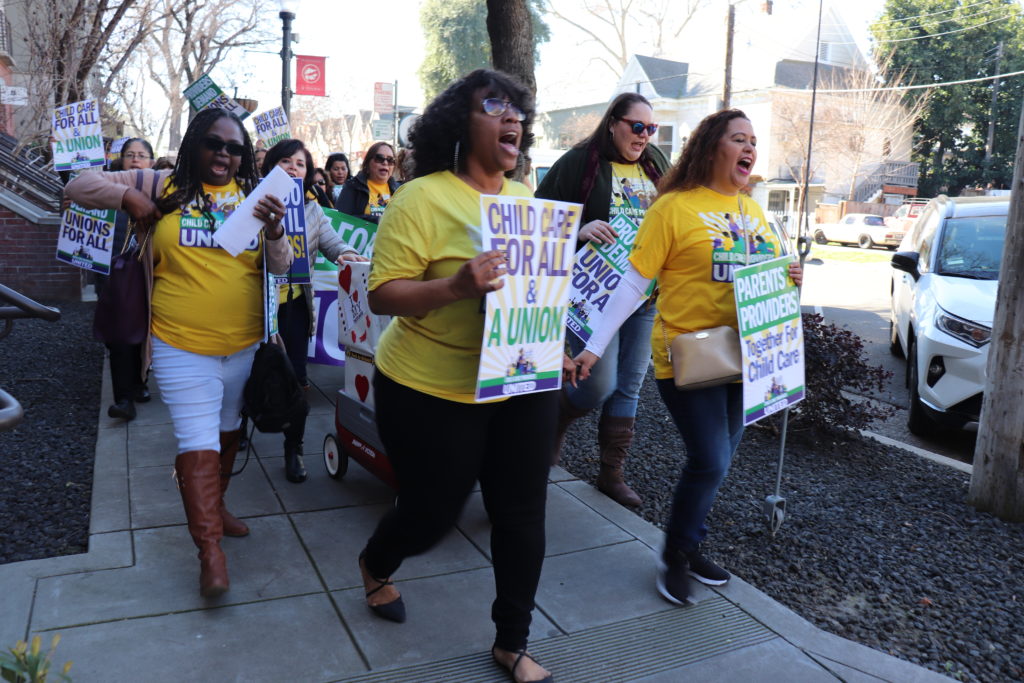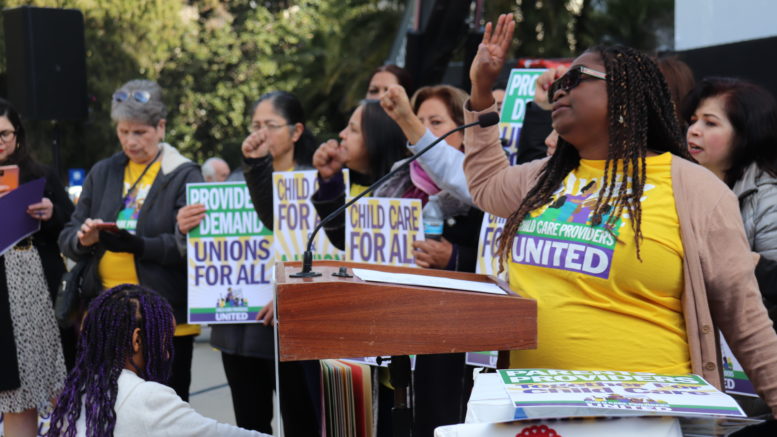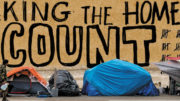Child-care providers stand on the brink of forming one of the largest unions in state history
During last decade’s Great Recession, Rasiene Reece became one of the millions of Americans to lose her home. When she moved from Lake Los Angeles to Victorville in 2008, she also left behind her small business, which provided home-based child care to working families.
“It was really hard. I ended up on welfare for a little while,” she said.
Reece eventually got back on her feet—sort of. Before the coronavirus outbreak caused an economic meltdown, Reece was coming up on two decades in the child-care profession, helping raise more than 300 children, including four of her own.
Many of those years were a struggle. Since the early 2000s, Reece and a growing number of the state’s subsidized child-care providers have called for higher rates, health care coverage and more subsidies for low-income families.
So in February, when Reece led more than 100 marchers to deliver paperwork for a union election to the California Public Employment Relations Board office, it represented a milestone.
“I joined this fight in 2003 and this is … a real moment,” Reece told the child-care providers packed into a PERB meeting room. Women of color made up a large portion of the crowd, and would represent the majority in a bargaining unit of approximately 40,000 providers across California.
The fight for collective bargaining rights for people who run “family child-care homes” has spanned three governors, an economic recession and a recovery that was underwhelming for most Americans. If successful, it will be part of one of the largest unionization efforts in state history—and signal the growing will of workers to withstand the challenges of trying to organize.
Workers at a tipping point
Unions became a tool for American workers to increase their power in the workplace with the National Labor Relations Act, the 1935 law that established private-sector workers’ rights to bargain collectively, form a union and strike.
After peaking in the mid-1950s, the number of Americans represented by unions has fallen dramatically. Unions have suffered blows in federal court, and from companies hiring union-busting firms. While most Americans view unions favorably, unions also face perceptions that they are sexist, racist and outdated.
Recently, though, collective action has seen a rise nationally. According to the U.S. Bureau of Labor Statistics, 485,200 workers walked out in 2018—up from only 25,300 in 2017. In 2019, 425,500 workers caused work stoppages. That two-year average was the highest it’s been in 35 years.
Union membership in California has also been rising slightly—up from 14.7% in 2018 to 15.2% last year. So why are more workers turning to collective action now?
Some say it’s because workers are feeling squeezed.
A California Budget & Policy Center report showed that the annual income growth of the state’s top 5% of earners outpaced those of the median and lowest 20% of earners. Between 2006 and 2018, those lowest earners actually saw a 5.3% decrease in income after adjusting for inflation, dropping from an average of $16,441 in 2006 to $15,562 in 2018. Workers in the middle saw a 6.4% earnings increase during that same period, but the top 5% saw their average income grow by 18.6%, by nearly $80,000.
In short, the rich got a lot richer while nearly nobody else did.
The scales have tipped in favor of the economic elite for decades, as workers have suffered stagnant wages and underemployment, explained Jane McAlevey, a senior policy fellow at the UC Berkeley Labor Center and a labor organizer. More families require two incomes, adding child-care costs to their financial balancing act.
“People are at wit’s end,” said McAlevey. She compared the desperation that many of today’s families feel to that of the 1930s Great Depression—and that was before the coronavirus pandemic.
“The period that led to the last huge upsurge of workers fighting back,” she added.
McAlevey released her third book, A Collective Bargain: Unions, Organizing, and the Fight for Democracy, in January. In it she cites extreme economic inequality and the failure of the American Dream as sources of worker unrest. “If you’re in the 90th percent or below of this country, you have maxed out every option,” she said.

A long road for child-care providers
Charlotte Neal sees parallels between her family and the ones she works with.
Neal runs a 24-hour child-care home in Natomas, where all of her families receive state subsidies. One of her parents doesn’t have a car, so she walks to work. When another woman was up for a promotion but didn’t have interview clothes, Neal loaned her some. Recently, one of her 14 children moved out of state with his father because California’s cost of living was so high.
The biggest stressors her parents face? “It’s the long hours and the low pay,” Neal said, before adding with a big laugh, “kind of like me.”
Standing in a living room filled with art supplies, toys and motivational wall posters, she was only half joking. “I understand and can relate to it,” she said.
The economic fallout from the coronavirus crisis has made a bad situation worse. Neal said one parent lost their job, another had their hours cut and some are working from home. All of them worry about their children catching the virus. This means Neal has only provided care for two children this week.
“We’ve been taking hits left and right,” Neal said Wednesday evening.
Operators of subsidized child-care homes are paid by the state through county social services departments or other agencies. Providers describe a system that’s not always smooth, with payments getting stalled if a parent forgets to file paperwork or being held up during a budget crisis. Reece remembers how state budget impasses during Gov. Arnold Schwarzenegger’s term hurt people like her.
“There were providers that just weren’t able to make it through that,” she said.
In 2003, Reece read about a rally at the state Capitol and went to meet other providers. What she found was a community who related to her challenges: payment issues, no health care and no sick leave or support.
She joined Service Employees International Union Local 99 and started hosting small union meetings out of her home.
“I realized that there were many providers that were facing some of the same issues,” she said. “And there were other issues that I had not yet faced that I was starting to become aware of.”
For the first year and a half, Reece’s meetings only attracted three to five regulars. Then she met a Palmdale-based child-care provider, Francis Ramirez, who raised the issue of Spanish translation. When Reece began hosting Spanish/English meetings out of Ramirez’s home, attendance quickly grew.
“From about four or five people to up to about 30 or 40 people every month,” Reece said.
Making progress
Last year, Child Care Providers United, or CCPU, was founded as a joint campaign under SEIU 99, SEIU Local 521 and United Domestic Workers/American Federation of State, County and Municipal Employees. Backed by these established unions, CCPU connected workers who are often isolated. If a majority of the 40,000 workers vote to unionize, CCPU will represent them in negotiations with the state.
“Our role is to empower and organize this workforce so that they can build a union that can become self-sustaining,” said Max Arias, executive director of SEIU Local 99 and CCPU board chairman.
Arias said goal No. 1 has been to pass a state law allowing subsidized child-care providers to bargain collectively. Then-Gov. Jerry Brown vetoed such a bill in 2011, blaming the state’s budget woes.
“Instead of just saying, ‘Well, let’s wait for another governor’ … we turned our attention to: ‘What can we do?’” Arias said.
What they’ve done since is boost workers’ rates, establish peer-training programs and win more slots for families to receive subsidized child care. The regional market rate, which the state uses to determine providers’ wages, has increased, and a 2017 law gave all providers access to direct deposit payments. They pushed for more than 7,000 additional slots in the state’s subsidized child-care program.
“It’s been 16 or 17 years of fighting that has really made legislators and people aware,” Reece said.
When Gov. Gavin Newsom signed Assembly Bill 378 into law last year, it paved the way for the state’s child-care providers to make history. Authored by Assemblywoman Monique Limón of Santa Barbara, the law afforded those workers the right to collective bargaining. With 40,000 workers, the campaign could result in one of the largest successful union organizing efforts in state history.
The California Public Employment Relations Board, or PERB, oversees the collective bargaining laws covering state employees including public school and university staff, trial court employees and, as of Jan. 1, subsidized child-care providers. Once PERB verifies proof of support for a union election, which the law set at 10% of the 40,000 child-care workers, they will vote on whether to unionize.
The large group that packed into the PERB office to deliver more than 8,000 signed authorization cards was itself unusual. Drop-offs are typically low-key and PERB accepts submissions online or by mail. But on Feb. 5, the roughly 100 child-care providers chanted and made impassioned speeches.
“I can say that it’s never happened at PERB in the same fashion,” said J. Felix De La Torre, the board’s general counsel. “For them it was a celebration. It will be probably the largest election in the state of California, at least in the public sector.”
The law gave the state an April 1 deadline to compile a list of child-care providers eligible to vote. Once the state submits the list to PERB, De La Torre said it should take two to three weeks to verify proof of support for an election. He doesn’t expect the coronavirus to slow down that process; neither does the California Department of Human Resources, which would hold the election.
Neal said given the economic fallout she’s seen in recent weeks, the union is more important than ever. It’s a fight that has been led by child-care providers, mostly women of color, countering some of the enduring critiques of unions.

Unions’ perception problems
Neal is open with parents that she belongs to United Domestic Workers and plans to vote ‘yes’ on unionizing as CCPU. Most have been supportive, but one expressed concern that the union would be controlling. Her fear reflected a criticism that unions are anti-democratic.
“We make the decisions together, it’s not just one person who’s ruling,” Neal said.
“Child-care providers are the ones that are organizing and making it happen,” said Ignacio Cardenas, lead organizer with United Domestic Workers. “They’re the ones out there signing up people to become part of their union. They’re making the phone calls. … This is all done by the members.”
In A Collective Bargain, McAlevey covers common misconceptions about unions, including assertions that they are typically sexist and racist. Much of her organizing career has focused on hospital workers and nurses, a largely female sector. The organizing efforts of teachers and child-care providers show that women are often at the forefront of new campaigns.
“It’s a rebirth, and it’s being reshaped largely…by a lot of women in what I call the mission-driven industries,” McAlevey said.
When Chicago teachers walked off the job in 2012 to massive public support, she said it reignited workers’ belief in their power. “I think that it began to re-raise the expectations of workers in the United States that the strike weapon was viable again,” she said.
According to the Economic Policy Institute, there is a strong correlation between declining union membership and greater inequality since the 1970s. The California Budget & Policy Center reported in 2018 that the state has more people in poverty than any other state, with one in five children below the poverty line in 16 counties.
McAlevey said while unions can reflect the sexism and racism in society, at their best they can help workers win political and economic power.
“The labor movement is not monolithic and far from perfect,” McAlevey said. “What it is, though, despite those warts, is the very best shot American workers have to reset income inequality and power inequality in this country.”
While the labor movement is growing, workers around the country often face an uphill battle.
Challenges to unions
Kingsley Melton wanted to form a union at Sacramento Charter High School. Three years later, he says the effort has forced him out of the teaching profession altogether.
Sac High belongs to St. Hope Public Schools, a charter school network founded by former Sacramento Mayor Kevin Johnson.
In spring 2017, St. Hope teachers submitted a petition to join the Sacramento City Teachers Association, the union that represents educators at Sacramento City Unified School District. At that time, St. Hope teachers said they were motivated to organize by high turnover, lack of budget transparency and poor classroom conditions.
Melton said some of his fellow teachers ultimately asked to have their names removed from the petition submitted to PERB because they feared retaliation from St. Hope. Being a primary organizer, he said he faced retaliation.
Melton said he had another class added to his already full schedule and received lower evaluations, which set him up for a pay cut. He said he believed he could no longer serve the students in his main class, Law and Public Service. Melton left St. Hope in 2018 and left teaching the following year, saying he may return to the classroom one day.
“It’s not an accident that I’m not there anymore,” Melton said. “They made it uncomfortable for me to stay.”
A St. Hope representative said they couldn’t discuss his case because it delved into personnel issues from several years ago.
St. Hope requested that PERB dismiss the teachers’ petition to join SCTA, arguing that substitute teachers should be included in the bargaining unit. PERB overruled that request, siding with the teachers. Negotiations on their first union contract were underway, but have been halted so they can focus on the immediate issue of distance learning during the coronavirus school closures.
According to the nonpartisan Center on Reinventing Public Education, the rate of unionized charter school educators in the country remained flat between the 2009-10 and 2016-17 school years.
McAlevey said that just as the 2012 Chicago teachers strike showed workers nationwide the power of striking, organizers can also look to their example to unionize charter schools.
“I think what workers are beginning to realize is … there’s this option that we need to sort of dust off and bring back, which is collective action,” she said.
But it always comes at a cost.
It took more than a decade for Reece and her fellow child-care workers to see the top of the mountain. That’s a long time to fight when you’re just trying to make ends meet—a point she made to those gathered in the PERB meeting room last month.
“I’m also a little sad for all my child-care provider friends that I’ve met along the way that have shut their doors due to us not having a voice,” she said then.
Their situation has worsened in recent weeks. Neal said she knows of one child-care home that’s closed since the coronavirus outbreak. She said a union would help them weather the storm. But if the crisis lasts very long, she worries that she could be the next one to close her doors.






Be the first to comment on "California—state of the unions?"